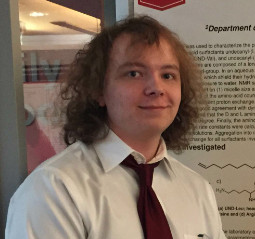Celebration of Scholars
An NMR Investigation of Micelle Formation by Amino-Acid-based Surfactants
 Name:
Burgoyne Hughes
Name:
Burgoyne Hughes
Major: Chemistry
Hometown: Greendale, WI
Faculty Sponsor: Kevin Morris
Other Sponsors:
Type of research: SURE
Funding: National Science Foundation
Abstract
Molecules that contain a non-polar hydrocarbon tail and a polar head group aggregate into structures called micelles. The center or core of the micelle contains the hydrocarbon chains. The charged head groups are on the micelle surface. In this research, NMR Spectroscopy was used to characterize the physical properties of micelles formed by the amino-acid surfactants undecanyl-(L)-leucinate (UND-Leu), undecanyl-(L)-valinate (UND-Val), and undecanyl-(L)-isoleucinate (UND-Ile). These surfactant molecules have been used to separate the mirror image forms of drugs. NMR spectroscopy was used to study the effect of solution pH on (1) micelle size and aggregation, (2) micelle binding by the enantiomers of the amino-acid counterions lysine and arginine, and (3) the rate of amide-solvent proton exchange. Micelle radii measured with NMR were found to be in good agreement with dynamic light scattering results. Additionally, it was observed that the D and L amino acid counterions bound to the micelles to the same degree. Finally, the amino acid headgroup amide-proton solvent exchange rate constants were calculated for both micellar and monomeric surfactant solutions. Aggregation into micelles decreased the rate of amide NH-solvent exchange for all surfactants investigated.
Submit date: March 14, 2016, 11:55 a.m.
